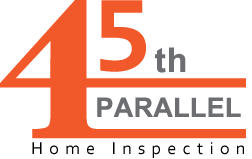Stucco Inspection Services
Stucco Inspection Information and Procedure
A stucco home has a distinctive, elegant look that many homeowners love. Stucco, whether it's the traditional type or the more modern synthetic stucco (EIFS), gives homes a smooth, refined finish that stands out. It’s a popular choice for homes, both as the main exterior and as an accent. However, like any building material, stucco needs regular maintenance and inspections to ensure it stays in good shape and protects your home.
That’s where 45th Parallel Home Inspection comes in. Our expert stucco inspectors are trained to identify any potential problems with your stucco, helping homeowners and potential buyers avoid serious issues down the road. Whether you're looking to maintain your home or you're considering purchasing a stucco property, a stucco inspection (or EIFS inspection) can provide the peace of mind you need to ensure your investment is protected.
Understanding Stucco: Traditional vs. Synthetic (EIFS)
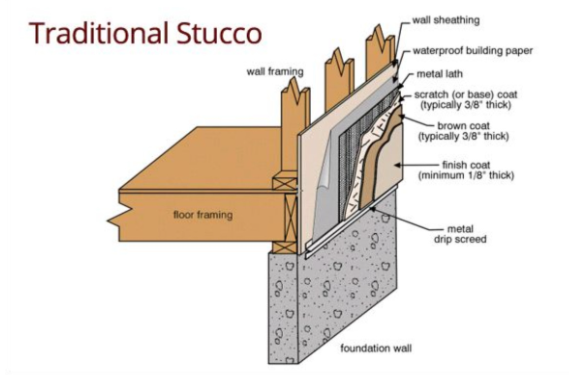 Stucco comes in two main types: traditional or hard coat stucco and synthetic stucco, also known as EIFS (Exterior Insulation and Finish System). Traditional hard coat stucco is currently made from Portland cement, sand, and lime, providing a durable, weather-resistant surface. Old stucco dating back thousands of years was made from sand, lime, and crushed marble and graces many facades still intact today centuries later.
Stucco comes in two main types: traditional or hard coat stucco and synthetic stucco, also known as EIFS (Exterior Insulation and Finish System). Traditional hard coat stucco is currently made from Portland cement, sand, and lime, providing a durable, weather-resistant surface. Old stucco dating back thousands of years was made from sand, lime, and crushed marble and graces many facades still intact today centuries later.
It is applied over a water-resistive barrier, followed by a mechanically fastened metal lath to provide the ‘key’ that holds the base coat, and then installed in three coats totaling approximately ⅞ inch thick. The three coats are the scratch coat, the brown coat, and the finish coat. There are some variations such as Western One Coat, which is actually two coats (scratch and brown combined, and a finish coat), and closer to ½ inch thick.
On the other hand, EIFS is a thin, textured finish coat applied over insulation board that has been prepared according to manufacturer specifications. The benefit of EIFS is that it provides additional insulation for the home combined with the elegant look of stucco.
While both systems provide an attractive, durable finish if installed properly, they are also prone to water intrusion issues if not properly installed or maintained. Cracks, gaps, and water intrusion can lead to water damage, mold, and even structural damage. These issues often go unnoticed on the surface, which is why regular stucco testing and inspections are essential to avoid costly repairs.
Stucco inspections are often a part of the real estate transaction when a house containing stucco is bought and sold. Home buyers want to know if there are any hidden issues prior to purchase and the buyers often want to know if there are hidden issues they should address prior to selling the home.
The Importance of a Stucco Inspection
Problems with stucco can often remain hidden until they become major problems that require expensive repairs. By getting a stucco inspection, you’re taking a proactive step in identifying any issues before they worsen. Whether you own a stucco home or are considering buying one, a comprehensive stucco inspection can help you avoid unexpected surprises.
At 45th Parallel Home Inspection, our inspection services are designed to catch potential issues early, saving you time, money, and stress in the long run.
The Stucco Inspection Process
Our stucco inspection process is thorough and designed to uncover any potential risks to your home. We perform both visual inspections and invasive inspections, using advanced tools like moisture meters and moisture probes to accurately assess the moisture content behind your stucco.
A visual inspection can identify obvious deficiencies, but only by probing below the surface can we uncover and verify moisture-related issues. Not only do we measure the moisture content of the wall structure beneath the stucco, but we also probe and feel for any decay below the surface that needs repair.
Visual Inspection
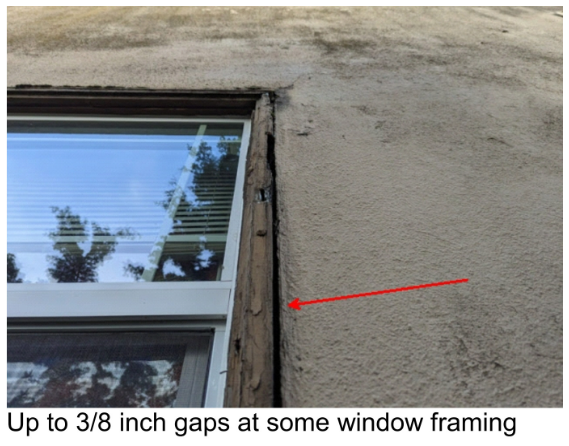 The visual inspection is the first step. Our inspectors will carefully examine the exterior of your stucco home, paying special attention to areas that are most likely to have issues, such as around windows, decks, doors, and flashings. We review the entire installation, both up close and from a distance, looking for signs of improper installation, damage, or failures in the sealants and flashings.
The visual inspection is the first step. Our inspectors will carefully examine the exterior of your stucco home, paying special attention to areas that are most likely to have issues, such as around windows, decks, doors, and flashings. We review the entire installation, both up close and from a distance, looking for signs of improper installation, damage, or failures in the sealants and flashings.
We often find issues such as failed or gapping sealant at critical areas like around windows and penetrations in the wall, and insufficient clearance of the stucco cladding from soft grade and hard grade. Stucco should have a minimum of 4 inches of clearance over soft grade like mulch and soil, and 2 inches from hard grade like driveways and walkways.
Old stucco will never have the same features that more current installations require because stucco installed 80 or 100 years ago did not have the same requirements back then. We do not recommend updating old stucco installations with current features like flashing unless we find an issue requiring repair. If repairs are required, it’s recommended to install the newer stucco repairs with current requirements.
In the visual inspection, we focus on specific areas like the windows, flashings, and around roof diverters (also known as kickout flashing), as well as any penetrations through the stucco system. Improper sealing or damaged flashings in these areas can allow water to get behind the stucco and become trapped, leading to water damage and potential mold growth. Our goal is to spot these problems and recommend the proper maintenance before they turn into costly repairs.
Invasive Inspection
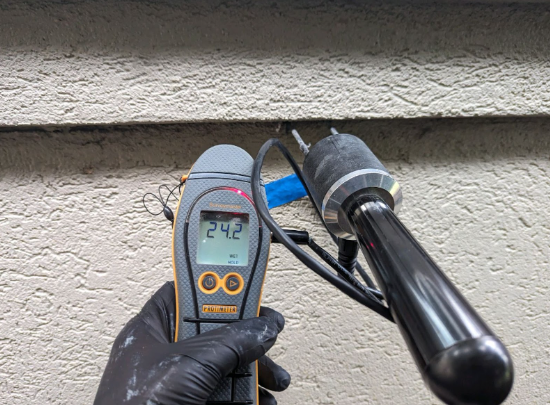 After our visual inspection, we move on to the invasive inspection. This step involves drilling small ¼ inch holes in key areas of your stucco to insert moisture probes. Every probe location gets two small holes to insert the moisture probes to check moisture content and feel for decay. The probes measure the moisture content in the wall sheathing behind the stucco. By checking the moisture levels, we can determine if there’s a risk of water damage or rot. While this is helpful, in extended dry periods, it will often tell us nothing of value.
After our visual inspection, we move on to the invasive inspection. This step involves drilling small ¼ inch holes in key areas of your stucco to insert moisture probes. Every probe location gets two small holes to insert the moisture probes to check moisture content and feel for decay. The probes measure the moisture content in the wall sheathing behind the stucco. By checking the moisture levels, we can determine if there’s a risk of water damage or rot. While this is helpful, in extended dry periods, it will often tell us nothing of value.
In conjunction with taking moisture readings, we have to probe for decay. That means we push against the moisture probes to see if it is able to push through the wall sheathing. We should never be able to push through normal and undamaged OSB or plywood wall sheathing unless it is decayed.
Only if it is water-damaged and decayed will we be able to push our probes right through the sheathing. In addition to checking the moisture levels, we assess the firmness of the sheathing to determine if it’s still structurally sound. If the sheathing feels soft or spongy, or if we are able to push the probes through the sheathing, that’s a sign of decay, and we’ll recommend exploratory openings be cut to further assess the condition and extent of any necessary repairs.
What’s Included in a 45th Parallel Home Inspection Report?
After we complete the inspection, you’ll receive a detailed report that outlines all our findings. Here’s a breakdown of what’s included:
- Sealant issues: Sealants around windows and doors can fail, allowing water to seep in.
- Clearance issues: Stucco should have proper clearance from soft grade and hard grade to prevent water from wicking into the walls, damaging the stucco, and pest intrusion
- Damage to the stucco: We look for and annotate damaged areas recommended for repair.
- Poor installation: We check for signs of improper installment that could lead to long-term damage.
Improper, missing, or damaged flashing: Flashing helps direct water away from the walls, and missing or damaged flashing can cause water infiltration. - Openings or penetrations: Any holes or penetrations in the stucco system should be properly sealed to avoid water intrusion.
- Moisture probe readings: We record the locations where we took moisture readings and include the results.
- Decay or damage: If we find any decay or structural damage, it will be clearly documented in the report.
We also provide plenty of pictures to back up our findings, giving you a clear visual of any areas that need attention.
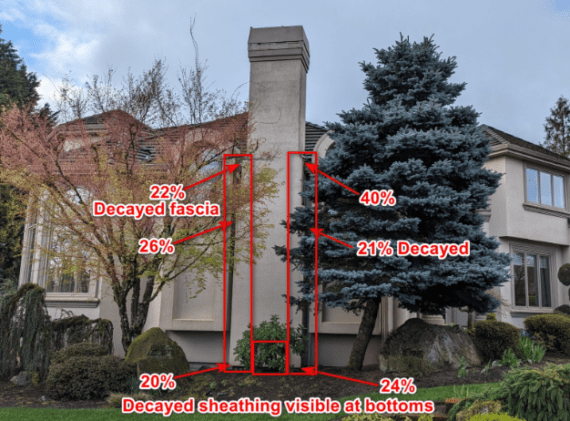
FAQs About Stucco Inspections
A stucco inspection involves performing a visual inspection, followed by invasive probing to check for elevated water content and decay in the wall structure behind the stucco. A detailed report is provided outlining the findings of the visual and invasive inspection portions.
If owning a home containing stucco, a stucco inspection can help you avoid costly repairs by catching problems early before they become major issues. If purchasing a home having stucco, it can help identify issues including costly necessary repairs before you purchase the home allowing you to negotiate repairs before purchase.
It depends. We do many inspections that have repairs that can be handled with a few thousand dollars because they are maintenance items or small repairs. Sometimes, we find issues and recommend the complete removal of the stucco and damaged wall structure below and re-siding the building.
The most expensive repair we have heard following our inspection process is approximately $300,000. Yes, that is three hundred thousand dollars. Those customers really got their money’s worth with our inspection. We estimate that almost every stucco inspection uncovers more in the cost of repairs than our inspection costs, making it a very good investment.
It depends. It starts at about $800. That would be for a situation where there is a smaller section of stucco such as on the front of the home only, one story, and not many windows. We evaluate every house to determine how much time it will take to perform the inspection, write the report, and provide a quote. It typically ranges from $800 to $3000 for most homes. It can be more depending on height, size, complexity, decks, number of windows, and other openings.
For larger commercial buildings, depending on the same factors of size, complexity, number of windows and openings, and height it generally starts around $2500. We will review and provide a quote.
Traditional stucco is made from cement, lime, and sand, and is applied in 3 layers totaling about ⅞ inch thick. EIFS (synthetic stucco) is a very thin ⅛ inch finish coat over prepared insulation boards for added energy efficiency. While looking like hard coat stucco at a glance, it is very different and much more fragile compared to hard coat stucco.
We use specialized tools like moisture meters and moisture probes to measure moisture content and assess the condition of your walls. Sometimes, Infrared cameras are helpful, but any moisture content or decay can only be verified with physical probing of the wall structure under the stucco.
A typical stucco inspection can take anywhere from three hours to all day, depending on the size and complexity of the home. On larger homes or commercial buildings, it can take multiple days.
Protect Your Home with a Stucco Inspection from 45th Parallel Home Inspection
Don’t wait until you notice water stains or cracks in your stucco—by then, could signal larger issues. If you are purchasing a home with stucco, we highly recommend a stucco inspection to check for hidden and costly damage. A professional stucco inspection from 45th Parallel Home Inspection can save you from dealing with major problems and costly repairs down the road. Our thorough process, detailed reports, and experienced inspectors will give you the peace of mind you need to make informed decisions about your current or prospective home.
Reach out to 45th Parallel Home Inspection today to schedule your stucco inspection and protect your home from hidden issues before they become a bigger problem!
Get answers from an Inspection Specialist
Give us a call today to answer any questions you have regarding home inspections, Radon testing, or sewer line inspections.
At 45th Parallel Home Inspection, we are committed to providing you with comprehensive and accurate inspection reports. Our expertise in stone veneer and stucco inspections can help protect your home investment. Contact us today to schedule your inspection.
We're Certified Inspectors
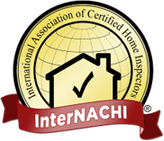

Schedule an Inspection Today
We are ready to schedule an inspection for you. Click the button and you can choose your date and time and do everything online. Or give us a call and we can schedule it for you.
